

Honda City MMC - Mid-Term Face-Lift
The Honda City, Honda's most successful model in Asia has just received its Minor Model Change (MMC). Launched in Thailand a couple of months ago as the City ZX, it is now making its away around Asia. Honda in Philippines was the first country outside of Thailand to adopt the MMC, launching it on September 2nd and now Honda Malaysia has launched it for Malaysia on October 11th. More importantly for me of course is that its launch here have give me the chance to check out this MMC and to get an idea of what have been done to the car.
Marketing wise, Honda have been getting more aggressive recently. Personally for me, this is a very good step in the right direction. For this City MMC, Honda Malaysia had already stopped production and delivery of the original City since almost 2 months ago, when the City ZX was launched in Thailand. Honda dealers, armed with info from the internet, brochures from Thailand, and apparently it seems blessings from Honda Malaysia, have already been accepting bookings for the new version for more than a month before the launch. And to complete the marketing exercise, Honda Malaysia generated suitable excitement by putting out teaser ads on national TV, telling people that the 'new City' will be launched on October 11th. This was in fact showing on air just a day after I got my media invitation to attend the launch event. Then in quick succession, I also received an invitation to the media test-drive event for the 'new' car, this time to the east coast town of Kuantan. The test-drive would start the day after the launch itself and is very nicely timed because it would offer me an almost immediate chance to experience the new version. It is also important because Honda R&D engineers was at the test-drive event to present a comprehensive coverage of what have gone into the MMC.
It's more than only skin-deep !
  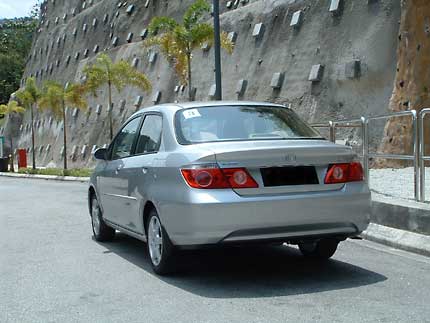  
|
Based on visual observation only, the changes made for the City MMC would seem to be only on the surface. The obvious changes are the rather significant revision to the exterior styling, specifically the front end. However as I learned from the technical presentation by the Honda R&D engineers at the media test-drive event, the changes are more than skin-deep, quite a lot more in fact. I will attempt to explain the details of the changes Honda made for this MMC, many of them in response to actual owners feedback or from observations of usage of the car in real-life situations made by Honda's engineers as they traveled extensively within the region during their R&D for this MMC. So to the many who were questioning if Honda really do listen to their customers, my personal opinion is that at the end of this preview, readers will agree with me that Honda really do. To explain the major changes in this MMC, the best way is to approach it via 2 angles : visual + features/functional changes and the mechanical/technical changes.
The design concept for this MMC City was described by Honda as 'Sporty Smart Sedan', what they christened S-3. The original City was especially popular with what Honda perceived as owners with a trendy & active lifestyle, to whom the unique combination of driveability with great fuel economy and great flexibility offered by the extra-large boot and the ultra-seats were especially appealing. For this MMC, Honda focussed specifically on enhancing the City's appeal to this market segment and also added two new target segments. First is the segment of 'young single females', whom they found formed a significant portion of the original City's buyers. The other is the segment of 'young enthusiast males', which from my understand is used to signify the many owners of the original City who have modified their cars (of which Honda Malaysia most definitely have seen a fair amount of). Bear this in mind as I cover the changes made in this MMC as a number of them are made in response to these two new target segments.
Another very important objective in this MMC is the desire by Honda to address the misconception that the City line-up comprises two grades of quality : a 'lower' grade City i-DSI and a 'higher' grade City VTEC. This is a wrong perception and for this MMC, Honda wants to firmly establish the fact that the two types : City i-DSI and City VTEC are 'different equals', each designed and packaged for its own specific target segment. So Honda wants to clearly establish a differentiation between the City i-DSI and City VTEC and that the person who selects the i-DSI most definitely have not chosen a 'lower' model. Neither have the person who selected the VTEC chosen a 'superior' one. But rather, they have each made their choice because of their particular preferences, both of which are equal and both valid ones.
ExteriorExterior-wise, the most glaring change made for the MMC would be the new front end treatment. Gone is the aerodynamically inspired sharply sloping front nose, replaced by a more traditional design that features a large front grille. This design is now more 'in-line' with the front-end treatment on Honda's other models here in Asia, in particular bearing a striking similarity to the Civic.
The whole front-end is a new design, inclusive of the front bumper. The front end is extended forward by 65mm (>2.5 inch) and upwards by 30mm (>1 inch). The objective is to give a more 'solid' look to the front end - what Honda R&D calls the 'impression of a powerful nose'. The items that have been changed are: new bumper, new headlights, new headlight positions, new front grille, and integrated foglights on the bumper.
The rear-end, the Achilles heel of the City has also been given attention. The combination of new tail-lights and a new rear bumper gives a slimmer and wider appearance to the rear end of this MMC City. Honda R&D says the rear-end too has been extended, by 15mm (>0.5 inch) mainly due to an all new rear bumper design. From a proper angle of view, a new more rounded rear can clearly be seen. The changed components for the rear end are the new rear combination tail-lights and a new rear bumper. The City VTEC also features a chromed tail-pipe finisher to complement its more sporty image to enthusiasts.
Other changes to the exterior includes 15" wheels for both i-DSI and VTEC types, this change clearly brought on by the many cases of owners of the original City i-DSI seeking clarification on the warranty issue from Honda for cases of wheel upgrade from the original 14" to 15" (which Honda R&D advised against). Also the side mirrors are now electrically foldable as well. Finally the fuel cap is now attached to the body by a plastic wire so when refueling, the driver does not have to worry about where to put the cap after opening it.
Two new colour choices has been added, or rather used to replace two existing colours. The new colours are Alabaster Silver Metallic (colour code NH-700M) and Habanero Red Pearl (colour code YR-557P).
 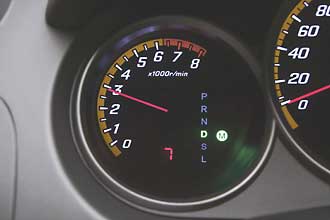  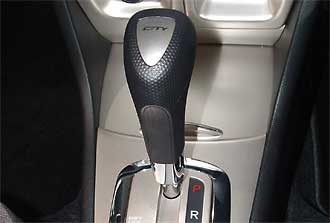 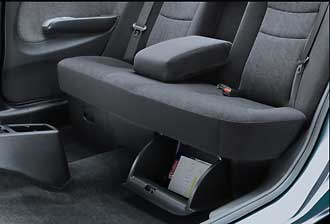  |
The interior of the MMC City received some important changes as well, eventhough the overall design remains pretty much the same as before. The theme adopted for the MMC interior is called "innovative style" by Honda R&D. The emphasis is to improve the impression of quality of the car. Much of the feedback learnt from observing actual enthusiast rides have been incorporated into the MMC interior. The i-DSI retains the Biege coloured interior but the City VTEC now comes with a black themed interior to differentiate it to the more enthusiasts type customers. This differentiation continues to the center panel, where in the i-DSI is trimmed with wood panels and in the VTEC, with silver metallic paneling. Learning from observations of customizations that enthusiasts did to their cars, the City VTEC gear shift lever comes with a gear-knob that has an emblem with the word 'CITY' on it. The idea is to provide 'pride of ownership' as Honda have seen for themselves first hand how enthusiasts (be it Honda or other makes) personalizes their cars with stickers or emblems (in this case, tastefully done). To complete the differentiation, the City VTEC comes with a stereo head-unit with MP3 capability while the steering wheel is leather bounded.
The instrument cluster is new, with the tachometer swapping position with the other meter which holds the fuel guage and gearbox mode selection indicator. This new cluster is common for both i-DSI and VTEC. The City VTEC however also comes with a similar illumination sequence for the instrument cluster as the Jazz VTEC, where varying levels of illumination 'welcomes' the driver depending on action, e.g. initial lighting up upon ignition key insertion. Then a 2nd level of brighter lighting upon turning to 'ON' position, and so forth.
A potentially controversial change to the interior of the MMC City will be the deletion of the much loved 'Ultra-Seats' on the VTEC and its replacement by standard seats (the i-DSI still retains the Ultra-Seats). The rear seats on the City VTEC MMC are now fixed, and the back-rest are not foldable but do offer a foldable center arm-rest. The main seating section is also a fixed design, unlike the folding design of the ultra-seat (which some detractors used to creatively called 'van-type bench seats' in an attempt to disparage the City). So there's no more 'tall mode' in the City VTEC MMC something which I personally found to be extremely useful. In an attempt to regain some storage flexibility in this new seating, Honda R&D has drawers built into the bottom, what they call an 'undertray'.
In response to a question by 1 member of the media, Honda R&D confirmed that with this new design, the seats between the i-DSI and VTEC are not exchangeable. I.e. those who values the Ultra-Seat will have to opt for the City i-DSI. The DIY enthusiasts who thinks that they might be able to get away with a City VTEC and then swap the Ultra-Seat over will be disappointed with a cross brace that runs across the rear of the back-rest. This means that even if the ultra-seats can be swapped over by some imaginative work, it still won't yield the space of the i-DSI because this cross brace will be blocking the access between the trunk/boot and the cabin.
Other changes to the interior are common to both models. The driver's seat now has an arm-rest. Cup holders are now built into the center console for the rear passengers as well and a nifty 'card holder' is available as well - this being the result of observations by the head engineer when he visited Malaysia and observed first-hand the sheer number of toll-gates we have here. This card holder is designed for drivers as a convenient place to keep the toll tickets or the pre-paid toll cards in between toll-gates.
For the all important human occupants of the car; the driver and passenger, Honda took great pains to ensure that less engine noise and outside noise, especially wind-noise, intrudes into the driving cabin. This is intended to offer a more luxurious feel to the car especially during high speed cruising.
The MMC City's trunk is now 'fully trimmed'. This is to mean to say that the trunk is now fully padded with no parts of the metal body showing. Honda proudly emphasizes that the City is the first in its class to offer this level of trimming.
The overall objective of the interior theme is the desire by Honda to enhance the impression of quality in the MMC City's interior as well as a desire to clearly differentiate the two types of City : i-DSI and VTEC.
There's a LOT more BENEATH the Surface !
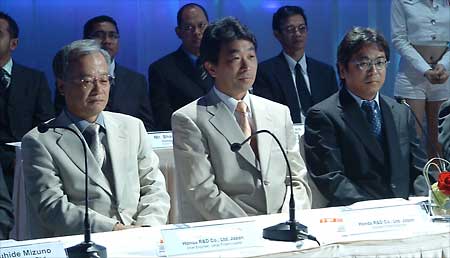 The R&D Engineers who led the City MMC |
On the day of the official launch of the City MMC, Honda Malaysia flew over a team of R&D engineers including the lead engineer for the City MMC project. During the press-conference in that launch, I asked and was told that other than the exterior/interior cosmetic and functional changes, the mechanical portions remained largely unchanged. In fact, I was told the only real change in terms of driving would be a revised CVT mapping plus some changes in suspension setting. At that time, I had thought that it would be trivial and all there is to the City MMC would be all that I have seen in the launch.
In the media test-drive event that took place immediately after the launch, journalists had a chance to share a car and drive it 200+km from K.L. to Kuantan. I drove a mixture of city roads and highway (the article will be out very soon after this one, I promise) and already I had a suspicion that the changes are not as trivial as they were made out to be in the launching press-conference. Later in Kuantan, the R&D engineer presented a complete technical overview of the changes made in the City MMC and I was absolutely floored by the sheer amount of detail changes that have been made to the mechanical side.
Engine, Gearbox and Engine BayThe engine technical specs published by Honda for this City MMC are completely identical with those for the original City. This lured me into a misconception that both the i-DSI and VTEC engines are completely identical (which the Honda R&D engineers also said during the launching press conference). However, when they did their technical presentation, they revealed that there are indeed several changes made to the engine itself, some of which I actually feel are very significant too.
Firstly there is a new header design. It is still stainless steel and is still a 4-to-1 design. However, firstly the individual runners are now shorter, they are straighter than the original design. Honda says this reduces the surface area of the header runners and retains heat better. This will help warm up the catalytic converter faster and directly contributes to a lower engine emission. In addition to this, the portion between the collector and the flange has been lengthened and the 'exhaust temp sensor' which used to be mounted to the cat itself, is now mounted to this new section of header piping. The rest of the exhaust is supposed to be identical to the original.
While the engine itself remains unchanged, the intake system has been changed. More specifically the intake duct design is new. This is done in conjunction with the new much improved cooling system which I will explain afterwards. But first I want to touch on the point where the intake system still opens out into the engine bay, i.e. the inlet to the air-filter box is still situated inside the engine bay. This is in direct contrast with the design on the Jazz as well as other models like the CR-V for e.g. The response from the R&D engineer is that while the Jazz/CR-V set-up might be superior for their design, for the Asian environment, putting the inlet inside the engine bay helps shield it from heavy rain. In addition, it was later clear to me that this inlet placement is a key part of the new integrated intake/cooling set-up which contributes a significant improvement to engine performance. I will explain what I mean below.

The City MMC features a nose that is extended 65mm further in front and 30mm higher. The front wheels however sits in the same place in relation to the cabin which means the L15A engine and gearbox also sits in the original place. What this translates to inside the engine bay is the creation of a 65mm of extra space between the front of the engine and gearbox and the nose of the car, where the radiator and air-cond condensers are. Honda R&D actually put this extra space to very good use. What they did was to design a new cooling fan. In the City, the radiator and air-cond condenser coil are full width items. So there are 2 fans that are bolted to the radiator and sits inside the engine bay. What we normally identify them as is that one is the radiator fan while the other is the air-cond fan. Honda however calls the radiator fan the 'main-fan' and the 'air- cond fan' the 'sub-fan'. In the original City, both these fans rotates in a clockwise direction (when seen from inside the car). What happens with this set-up is that the spiral pattern caused by the rotating blades causes the air-flow to sort of swerve right (towards the driver's side) upon hitting the engine. With the City MMC's new engine bay design, Honda's R&D engineers changed the sub-fan's rotating pattern to an anti-clockwise direction. This rather ingenious new setup means that the air-flow that comes out from both fans are in opposite spiraling pattern. What happens when they hit the engine/gearbox is that while the main fan's air-flow continues to swerve right, the sub-fan's air-flow now swerves left (i.e. towards the front passenger side). By careful positioning of the new intake duct inlet, Honda R&D exploited the extra space in the engine bay with this new air-flow pattern and actually created a cooler air-temperature in the area around the intake inlet. The nett result of this is a reported reduction in IAT (Intake Air Temperature, measured at the mouth of the throttle body and which is a measure of the temperature of the air entering the combustion chambers) from 54 degrees C down to 48 degrees. This is an astonishing drop of 6 degrees or slightly over 10% !! Such a large drop in IAT will definitely contribute to a good increase in engine power. The 'sub-fan' is a brand new design, with a new motor as well as new motor casing. Such an ingenious mod is most definitely something worthwhile to consider retrofitting or DIY'ing into our own cars. So I spent some time questioning the R&D engineers about whether it's possible to retrofit this new sub-fan to the original City. The R&D engineer's feedback is 'NO'. The fan casing itself is different, being thicker. Furthermore, even if we can somehow hack the mod in, it still won't deliver the same result on the original City because this new air-flow system is designed to exploit the 65mm of extra space in the front of the engine-bay. Put it another way, a counter-rotating sub-fan on the original City will not be able to produce the same level of ventilating air-flow to the filter inlet simply because there's not enough empty space.
With regards to this, the combination of a new header design and this drop in IAT, another journalist questioned Honda about the max power rating of the L15As : surely the power available from the engines should be more than just 88ps and 110ps ? To this the Honda R&D engineers remarked that they feel that the power increase will be mainly in the low-end and mid-range. This will show up in so called 'driveability' but in terms of outright oomph, for top speed for e.g. there should not be a noticeable difference. My own input for this is that one must bear in mind that the max power ratings for the engines were done in laboratory environments, i.e. more or less ideal conditions, certainly not in real-life on-the-road conditions like traffic jams and so forth. So in real-life usage, the engines are obviously delivering less than their rated max powers (especially when one has been stuck in a crawl for hours). In this case, the reduction in IAT helps to ensure that the engines deliver near their rated power in as many common day situations as possible. Certainly I am very confident that there will be a huge difference in power delivery from the car when one has been stuck in a crawl for a long time. So in this sense, the reduction in IAT will not contribute to a higher max power. The new header might but as the hard-core enthusiasts will know, seldom will a header mod really contribute to any significant amount of max power increase. Typically it will be low-end or mid-range increase. If we take these into consideration, then the R&D feedback certainly makes plenty of sense !
Both the CVT and the EPS have also received new settings. The CVT has a new ECU mapping which is designed to enhance the driving feel, especially the sportiness of the City VTEC. I asked the R&D engineer about the gear ratios for the 7-speed mode and was told they are slightly changed, again for a sportier driving performance. The EPS has been set to give a more solid feel to the steering wheel as one of the major feedback about the original City is how many are not used to the super light steering weight of the EPS. This 'tuning' for sportier performance and enhanced driving feel is carried into the cabin space where the pedals (both brake and throttle) have been revised to give a solid feel, with less overall travel.
Another very significant change inside the engine bay is the enhanced air-conditioning system. The major change here is a new air-cond compressor which has an attached oil separator. What this does is to separate the compressor oil (which is needed to lubricate the compressor) and the air-cond gas (which is the new CFC-free type). The idea is that in ordinary compressors, the lubricating oil flows together with the cooling gas. So when it is cooled at the condenser, both the gas and the oil has to be cooled. But there's actually no real benefit in cooling the compressor oil. One of the feedback from City owners have been the rather lack-lustre performance of the air-conditiong system. It doesn't really have enough 'power' to cool the car on very hot days. To improve the cooling capacity of the system, one way would be to fit a larger condenser coil and a larger compressor. But a larger compressor will incur a higher parasitic power loss on the engine, anything from 2-5 ps extra power loss. For an engine like the L15A, which depends a lot on efficiency and reduction of unnecessary power losses, this is not acceptable. So the new compressor design has two separate circuits, one for the oil which circulates in its own and one of the cooling gas which goes the normal route (receiver, condenser, compressor, cooling coil). Now the system cools only the gas and not the oil and this allows the current system to give much more efficient cooling.
So as can be seen here, there are a number of really significant changes to the engine bay of this City MMC, things which are most definitely not visible by casual inspection. Some of the components that are involved, except the new header, are visible but without the inside info from the R&D engineers, we will definitely not be able to appreciate the large amount of improvements that they contribute.
Suspension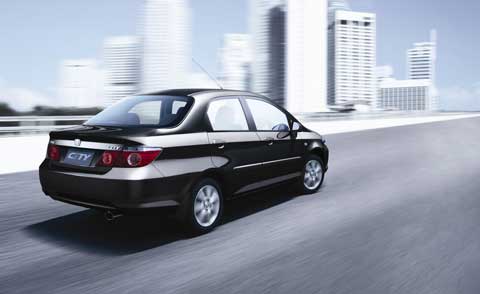 The final area on the City MMC where significant upgrade has been done is the suspension.
For this MMC, Honda R&D focussed improvements on 4 main areas which they consider as
crucial. First is what they termed harshness which is used to mean how comfortable
the car is over rough, uneven road conditions. Second is Flat Ride which they
use to denote the control of body roll during high speed cornering. Third is Response
which they use to denote the 'responsiveness' of the turn-in during lane changes or
cornerning. Finally is Safety which denotes the stability of the car during hard
performance driving, over twisty roads and so forth. The target here is to reduce
body roll and over-steer. To achieve their targetted improvements in these areas,
Honda went and revised the whole suspension !
The final area on the City MMC where significant upgrade has been done is the suspension.
For this MMC, Honda R&D focussed improvements on 4 main areas which they consider as
crucial. First is what they termed harshness which is used to mean how comfortable
the car is over rough, uneven road conditions. Second is Flat Ride which they
use to denote the control of body roll during high speed cornering. Third is Response
which they use to denote the 'responsiveness' of the turn-in during lane changes or
cornerning. Finally is Safety which denotes the stability of the car during hard
performance driving, over twisty roads and so forth. The target here is to reduce
body roll and over-steer. To achieve their targetted improvements in these areas,
Honda went and revised the whole suspension !
For the front suspension, the springs are stiffer while the shocks have been tuned to complement the higher rate. The damper bump-stops are now urethane instead of rubber ! The suspension bushing positions have also been changed to work in conjunction with the new spring/damper components while the front suspension knuckle has also been improved. The front anti-roll bar is larger with an improved 'lever ratio', i.e. stronger twist control to help reduce body roll during hard cornering. Finally the anti-roll bar bushings are now stiffer.
For the rear suspension, the spring rate have been reduced and the shocks again tuned to complement the new softer rate. The suspension bushes are also improved. The rear anti-roll bar is now smaller.
It is probably not a great exaggeration to say that Honda engineers have designed an almost new suspension for the City MMC. Virtually all the major components in the suspension except for the suspension arms have been upgraded or changed ! The improvement this 'new' suspension have made to the City ride-quality and handling was very apparent during the test-drive to Kuantan.
Conclusion

Since its launch here in 2002, Honda Malaysia have sold more than 25,000 units of the original current generation Honda City. This model is now sold in 33 countries worldwide and have already netted over half a million units in total sales, making it one of the most successful model in Honda's line-up worldwide. Still, there is one target which have eluded this amazing car. In most of ASEAN, the City has lost out to its arch-rival, the Toyota Vios in terms of out-right sales. There are many reasons for this, looks, timing (Honda took too long to introduce the City VTEC, allowing the Vios to take away many potential sales to buyers who desired a more powerful car), and so forth.
All these things Honda seeks to redress with this latest MMC of the Honda City. At the same time, I think it is clear that Honda has also taken great pains to address many of the more important complaints that they have received from their current customers. The end result is an MMC which have made the City a greatly improved car. Honda Malaysia's sales target for this City MMC is 1,000 units a month, with an expected split between the i-DSI and VTEC at 60 : 40.
The media test-drive event that immediately followed the launch took place during the end of the week when the City MMC was launched. It allowed me to sample briefly both the MMC City i-DSI and City VTEC. In my next article on this MMC City, I will write about my impressions from that test-drive.
Wong KN
October 2005
© Temple of VTEC Asia